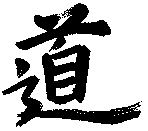 |
Taoism And The Taoist Arts |
|||
Taoist Martial Arts |
||||
Background & History: The Taoist Arts: |
Practice of martial arts may not seem at first to be a particularly Taoist
pursuit - after all martial means 'war like' and these skills are used to injure
others. However, there is actually no contradiction - Taoist martial artists
learn to defend themselves, not to attack others. At the same time they develop
suppleness, fitness and timing. Success in the martial arts requires discipline,
self-control and perseverance, thus they are also spiritual and mental activities.
"The ultimate goal of studying the arts of war is not to harm but rather to heal, enhance, and preserve life " Legend dictates that the Martial Arts originated at the Shaolin Temple in the Honan province of Northern China, where they were introduced by Boddhidharma (Ta Mo in Chinese). This legendary figure was said to be a wandering monk who came over the mountains from India, bringing with him the fighting techniques and philosophy of his home land. However, it is likely that rudimentary martial arts were being practiced long before that for self defence and good health. Whatever their origin the number of styles of martial arts is now immense, and nowhere more than in the Orient. Even today there are some styles that will only be taught to Chinese, and in-fighting between styles still takes place from time to time. But the culture of secrecy which was necessary when China was a world of warring factions is almost gone and the number of styles available to the Westerner is enormous. Most of the martial arts found in the West are the 'hard' or 'external' styles where the emphasis is on physical strength and brute power. These styles encourage hard training, development of strength and an aggressive nature. But these are not Taoist arts for they neglect the yin side of our nature - the Taoist martial arts are the 'soft' or 'internal' styles such as T'ai Chi, Pa Kua, Hsing I and Kung Fu. These arts require physical fitness but not large muscles. They utilise leverage, good posture and balance in order to dissipate, negate or redirect the strength of an attack. The internal arts tend to use circular movements and concentrate on developing sensitivity and timing. Most of all practitioners seek to develop and harness the chi or internal energy and eventually use it for martial applications. Of all the internal styles, T'ai Chi is probably the softest and is rarely taught in this country as a martial art at all. And at the other end of the scale is Hsing I which utilises fast direct attacks and draws heavily on the 5-elements theory and 12 different fighting styles based on animal movements. In between are the various styles of Kung Fu and styles such as Pa Kua (Ba Gua) which teaches that if the 8 directions (of a compass) can be defended one cannot be harmed, and uses circular movements in order to approach the opponent from the side or rear.
As a Chinese martial art, kung fu is based on Taoist (and to a lesser extent Buddhist) philosophy, and the practitioner must develop a good understanding of the theories before reaching the higher levels of the art. Though most styles are internal, there are harder styles of kung fu, too. These include Wing Chun (the style Bruce Lee learnt) and Praying Mantis. Other Martial Arts:KARATEOriginating in Okinawa, an island between Japan and China, Karate grew from traditional Chinese roots, blended with indigenous fighting styles. The island was invaded by the Japanese in the early 17th century, and by the early 20th century Okinawan masters were teaching their arts in Japan; It was about this time that the name 'karate' was coined. Modern Japanese Karate is very much an external form, and in the West has almost completely lost touch with its spiritual roots. This is a shame, as Karate has a long history of spirituality, and the original Okinawan arts contained many internal elements. Literally translated as 'empty hand', Karate deals with solid, powerful blows with all parts of the body. Many styles also use weapons. All styles practice 'kata' - set routines practiced alone to improve technique. Well known styles include Wado-ryo and Shotokan. THAI KICK BOXINGThai kick boxing (or Muay Thai) is extremely popular as a spectator sport in Thailand. Demanding high fitness levels and sharp reflexes, this is a powerful and aggressive external art. JIU-JITSU AND JUDOJiu-Jitsu, the predecessor of Judo, was the martial art of the Japanese Samurai. It deals with grapples, grips, joint locking and single strong blows to pressure points or other sensitive areas. Jiu-Jitsu was strongly bound into the Samurai code of ethics, and with Zen philosophy - discipline was extremely strict, and was supposed to govern everyday actions. Modern Jiu-Jitsu keeps the emphasis on manipulating and locking joints, though many of the more lethal techniques have been lost, or are no longer taught. Judo, although based on Jiu-Jitsu, is not a martial art but a sport, using holds and throws. TAEKWON-DOTaokwon-do is a Korean martial art which emerged during the 2nd World War. It was created by a Korean General named Choi Hong Hi as an attempt to unify the many splintered martial arts in the country. The style is famous for its powerful kicks. AIKIDOFounded in Japan in the 1940s, Aikido ('way of harmony') is really an internal art, based on defense not attack, and utilisation of 'ki' (the Japanese rendering of the Chinese 'chi'). The ultimate aim of Aikido is self realization through unification and control of mind, body and ki. The movements in Aikido are fluid and soft, with deft footwork that is hidden from the opponent by the long split skirt called a hakama. JEET KUNE DOA fusion of martial arts created by the legendary Bruce Lee. Incorporating kung fu, western wrestling, T'ai Chi and karate, it is an external art which teaches fluid movements and spontaneity and shuns set forms.
The Way of the Warrior by Chris Crudelli. A gorgeously illustrated and very wide-reaching encyclopedia of martial arts. Very highly recommended. To find out more about this book or to order a copy visit the Taoist
Bookshop (click here for the
UK store.) |
|||
|
|
||||

 Kung fu was brought to the
attention of the West primarily by Bruce Lee. His success spawned a string of
films and books, and kung-fu teachers appeared in every city. As other martial
arts gained in popularity, kung fu became just one of the many options available
to the eager beginner, nevertheless in kung fu alone there are many styles to
choose from.
Kung fu was brought to the
attention of the West primarily by Bruce Lee. His success spawned a string of
films and books, and kung-fu teachers appeared in every city. As other martial
arts gained in popularity, kung fu became just one of the many options available
to the eager beginner, nevertheless in kung fu alone there are many styles to
choose from.